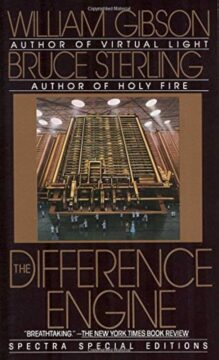Josh Rothman at The New Yorker:
 In 1990, Gibson and Bruce Sterling wrote “The Difference Engine,” an alternative-history novel, set in the nineteenth century, in which computers are built about a hundred years earlier than in reality, using quirky systems including gears, wheels, and levers. The novel helped popularize the genre of steampunk, in which nineteenth- and twentieth-century technologies are merged. Arguably, Jules Verne and H. G. Wells wrote steampunk avant la lettre, simply by crafting science fiction in the late nineteenth century; the genre’s aesthetic markers—valves, pipes, airships, monocles—have since informed the imaginative worlds of films and television shows like “Snowpiercer,” “Silo,” and much else. Steampunk mounts an imaginative protest against the apparent seamlessness of the high-tech world; it’s an antidote to the ethos of Jony Ive. It’s also fun because it’s counterfactual. It’s fascinating to imagine, implausibly, how ravishing technology could be constructed out of yesterday’s parts.
In 1990, Gibson and Bruce Sterling wrote “The Difference Engine,” an alternative-history novel, set in the nineteenth century, in which computers are built about a hundred years earlier than in reality, using quirky systems including gears, wheels, and levers. The novel helped popularize the genre of steampunk, in which nineteenth- and twentieth-century technologies are merged. Arguably, Jules Verne and H. G. Wells wrote steampunk avant la lettre, simply by crafting science fiction in the late nineteenth century; the genre’s aesthetic markers—valves, pipes, airships, monocles—have since informed the imaginative worlds of films and television shows like “Snowpiercer,” “Silo,” and much else. Steampunk mounts an imaginative protest against the apparent seamlessness of the high-tech world; it’s an antidote to the ethos of Jony Ive. It’s also fun because it’s counterfactual. It’s fascinating to imagine, implausibly, how ravishing technology could be constructed out of yesterday’s parts.
But what if the world really is constructed that way? In that case, it could be a mistake to put too much faith in digital perfection. We might need to fiddle with our technology more than we think. And we might also want to see it differently—less as an emanation from the future, and more like an inheritance from the past, with all the problems that entails.
more here.
Enjoying the content on 3QD? Help keep us going by donating now.
